MECHELEN, Belgium — The confessionals where generations of Belgians admitted their sins stood stacked in a corner of what was once Sacred Heart Church, proof the stalls — as well as the Roman Catholic house of worship — had outlived their purpose.
The building is to close down for two years while a cafe and concert stage are added, with plans to turn the church into “a new cultural hot spot in the heart of Mechelen,” almost within earshot of where Belgium’s archbishop lives. Around the corner, a former Franciscan church is now a luxury hotel where music star Stromae spent his wedding night amid the stained-glass windows.
Across Europe, the continent that nurtured Christianity for most of two millennia, churches, convents and chapels stand empty and increasingly derelict as faith and church attendance shriveled over the past half century.
“That is painful. I will not hide it. On the other hand, there is no return to the past possible,” Mgr. Johan Bonny, bishop of Antwerp, told the Associated Press. Something needs to be done and now, ever more of the once sacred structures are repurposed for anything from clothes shops and climbing walls to night clubs.
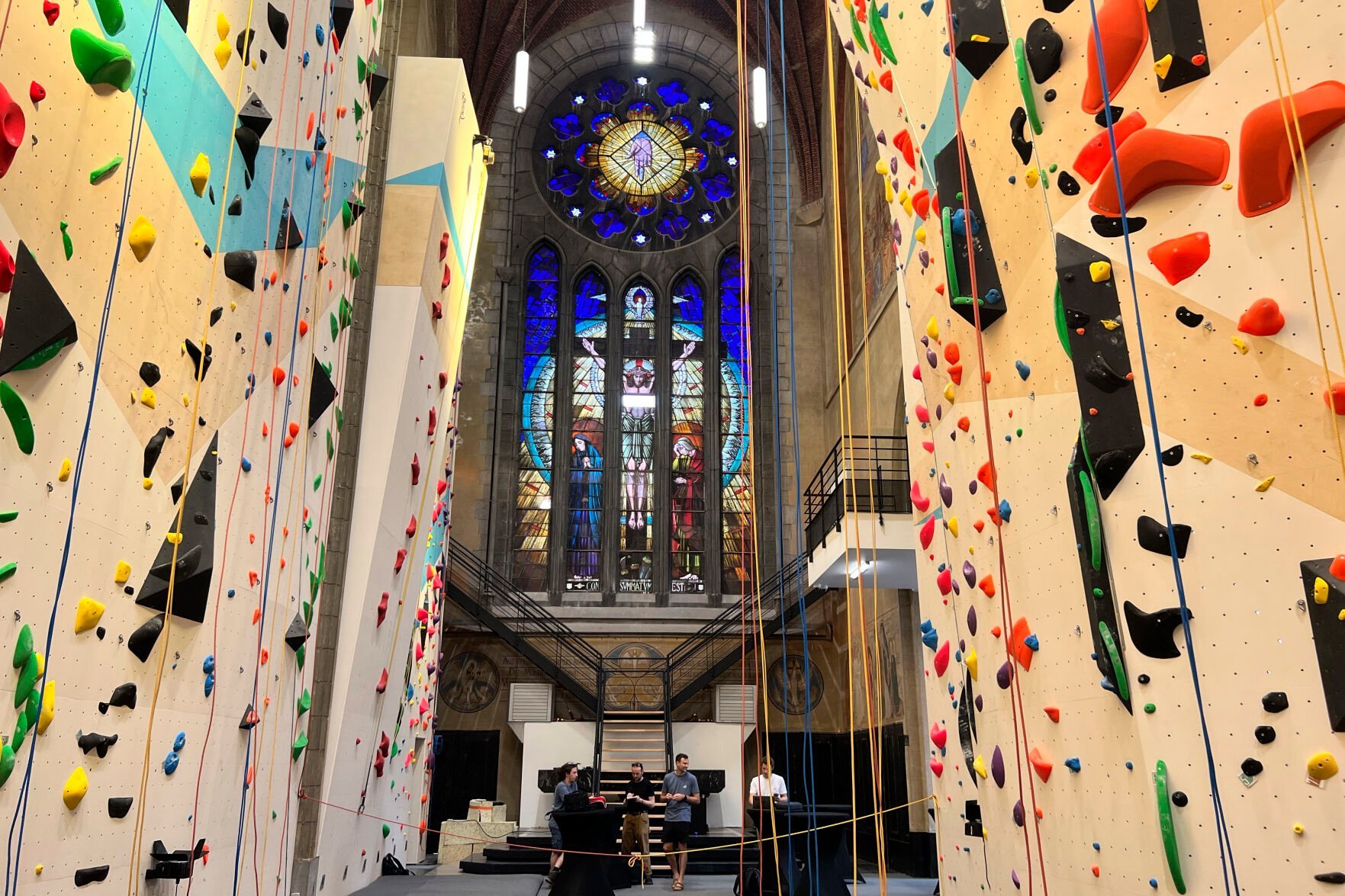
Sylvain Plazy
People stand in back of ropes for a climbing wall in the repurposed Saint-Antoine church in Brussels, Belgium, Wednesday, June 21, 2023. Across Europe, the continent that nurtured Christianity for most of two millennia, many churches, convents, beguinages and chapels stand empty as faith and church attendance have dwindled over the past half century. Many are now been repurposed to preserve their historical and architectural relevance, while others have opened up to non-religious activities to expand their use. (AP Photo/Sylvain Plazy)
It is a phenomenon seen over much of Europe’s Christian heartland from Germany to Italy and many nations in between. It really stands out in Flanders, in northern Belgium, which has some of the greatest cathedrals on the continent and the finest art to fill them. If only it had enough faithful. A 2018 study from the PEW research group showed, in Belgium, that of the 83% that say they were raised Christian, only 55% still consider themselves so. Only 10% of Belgians still attended church regularly.
Nowadays, visiting international choirs may find that their singers outnumber the congregation.
On average, every one of the 300 towns in Flanders has about six churches and often not enough faithful to fill a single one. Some become eyesores in city centers, their maintenance a constant drain on finances.
Mechelen, a town of 85,000 just north of Brussels is the Roman Catholic center of Belgium. It has two dozen churches, several huddled close to St. Rumbold’s cathedral with its UNESCO World Heritage belfry tower. Mayor Bart Somers has been working for years to give many of the buildings a different purpose.
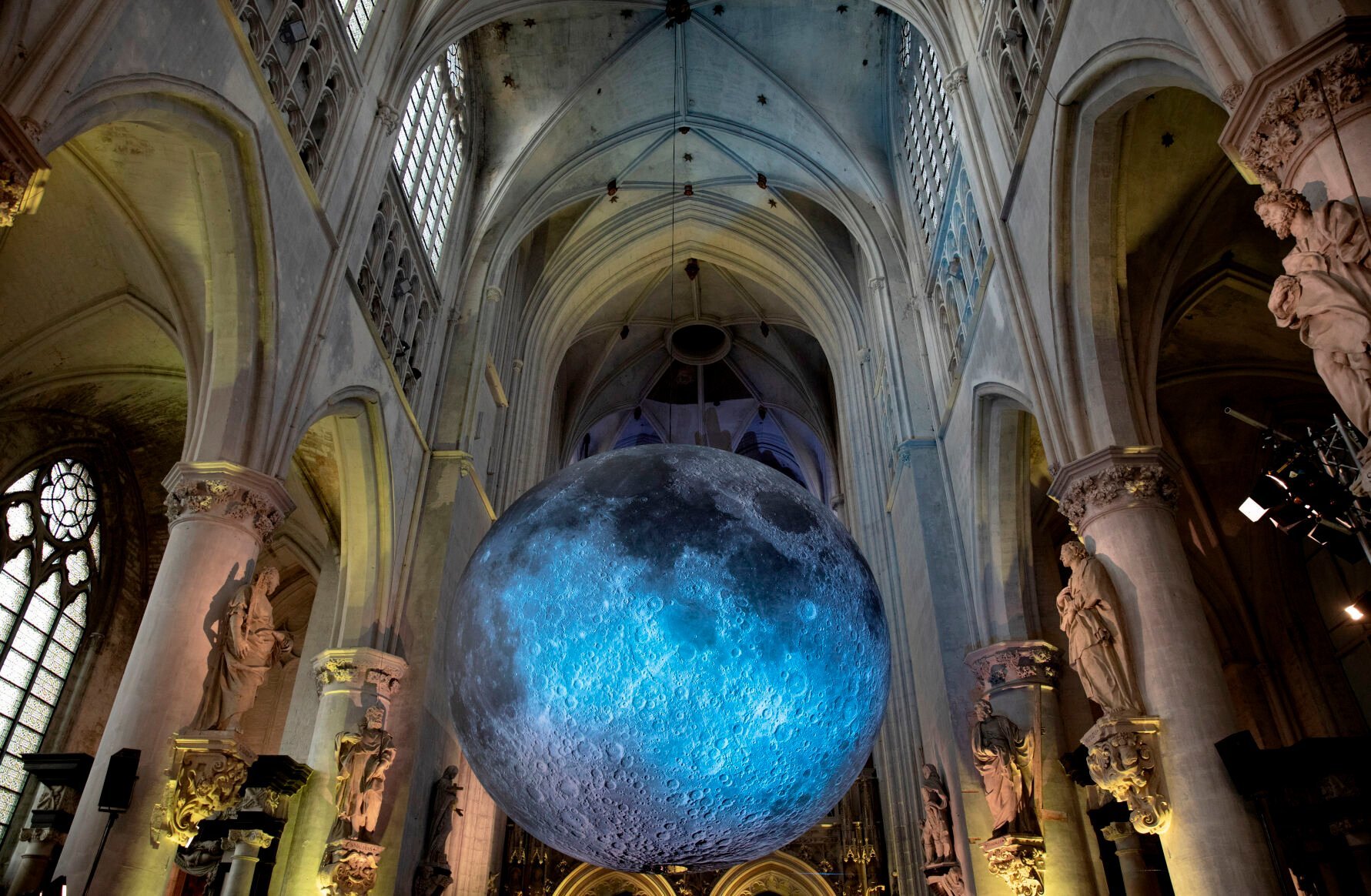
Virginia Mayo
FILE - The Museum of the Moon art installation by artist Luke Jerram at the St. Rombouts Cathedral in Mechelen, Belgium, Dec. 14, 2019. Across Europe, the continent that nurtured Christianity for most of two millennia, many churches, convents, beguinages and chapels stand empty as faith and church attendance have dwindled over the past half century. Many are now been repurposed to preserve their historical and architectural relevance, while others have opened up to non-religious activities to expand their use. (AP Photo/Virginia Mayo, File)
“In my city we have a brewery in a church, we have a hotel in a church, we have a cultural center in a church, we have a library in a church. So we have a lot of new destinations for the churches,” said Somers, who as Flemish regional minister is also involved in repurposing some 350 churches spread across the densely populated region of 6.7 million.
A landmark repurposing project in Belgium was Martin’s Patershof hotel in Mechelen, where the interior of the church was gutted to create rooms where the beds have headboards resembling organ pipes and a breakfast room next to the altar where wafers of gold leaf hover overhead. “We often hear that people come here to relax and enjoy the silence of its former identity,” said hotel manager Emilie De Preter.
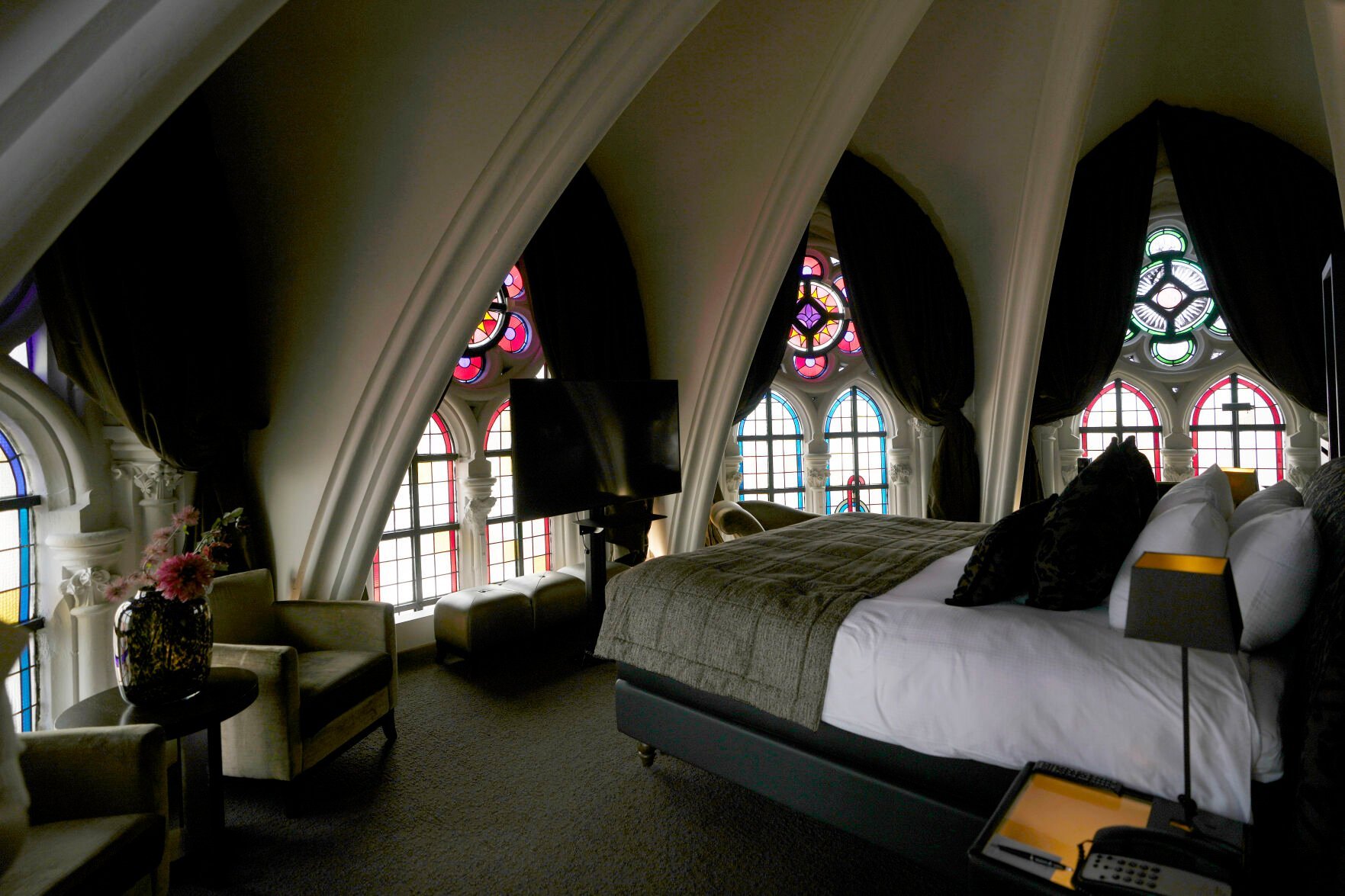
Virginia Mayo
Sunlight filters in through stained glass windows in a guest room at the Martin's Patershof hotel in the center of Mechelen, Belgium, Monday, June 19, 2023. Across Europe, the continent that nurtured Christianity for most of two millennia, many churches, convents, beguinages and chapels stand empty as faith and church attendance have dwindled over the past half century. Many are now been repurposed to preserve their historical and architectural relevance, while others have opened up to non-religious activities to expand their use. (AP Photo/Virginia Mayo)
With its understated luxury, it offers contemplation, and more.
“In the hotel, people sleep in a church, maybe have sex in a church. So you could say: ethically, is it a good idea to have a hotel in a church? I don’t have so many hesitations,” said Somers. “I am more concerned about the actual architectural value.”
In nearby Brussels, the Spirito night club has taken over a deconsecrated Anglican church and has a drawing of a priest kissing a nun as its logo.
It is not exactly what Bishop Bonny had in mind.
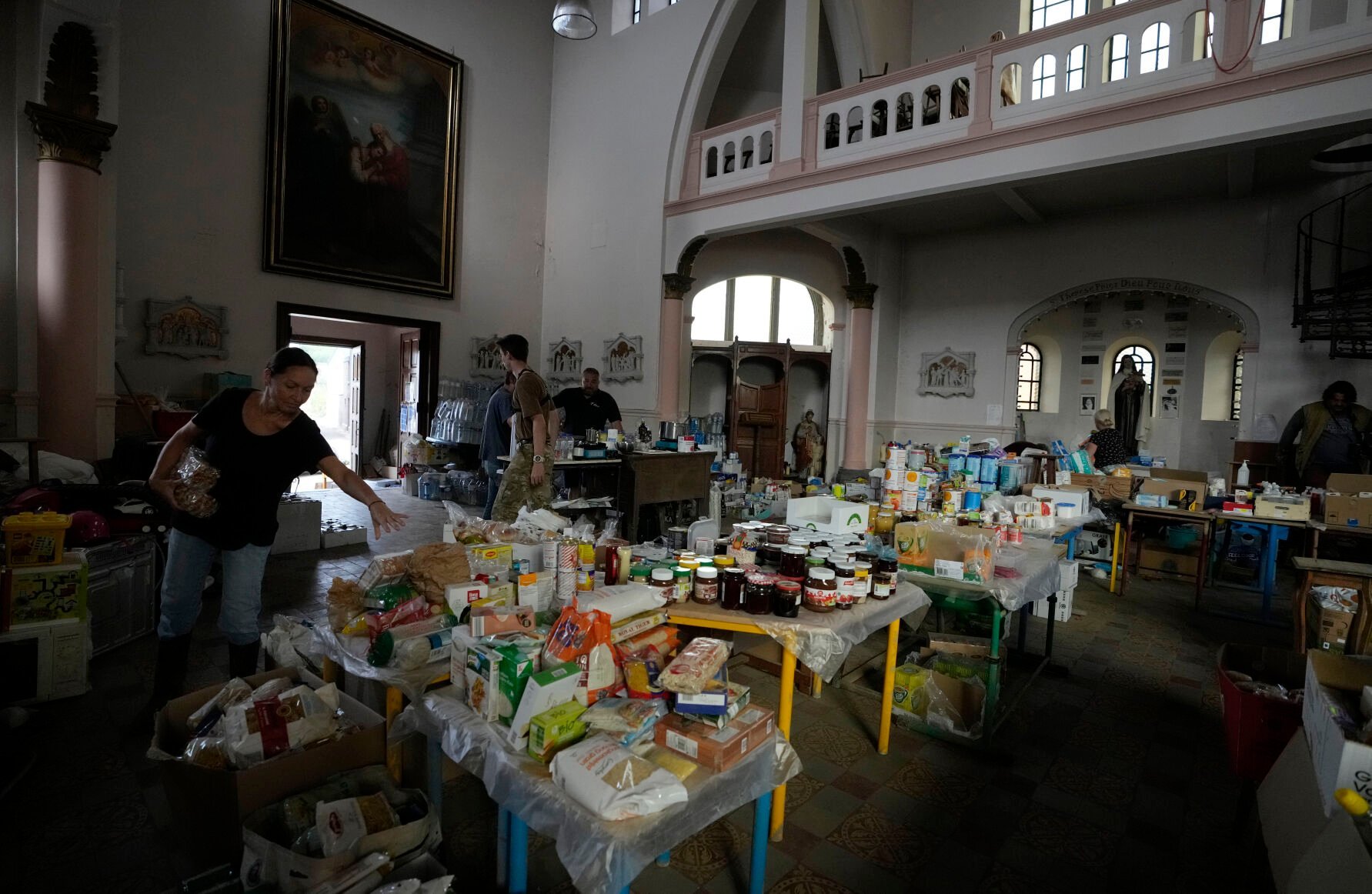
Virginia Mayo
FILE - Victims of flooding shop for items distributed by volunteers at the town church in Trooz, Belgium, July 27, 2021. Across Europe, the continent that nurtured Christianity for most of two millennia, many churches, convents, beguinages and chapels stand empty as faith and church attendance have dwindled over the past half century. Many are now been repurposed to preserve their historical and architectural relevance, while others have opened up to non-religious activities to expand their use. (AP Photo/Virginia Mayo, File)
Even if Roman Catholic religion is on the wane, a sense of the sacral or a need for reflection is also still present in society, whether one is religious, agnostic or atheist. And the aura of tranquility emanating from a church is hard to match. So for Bonny, there is no reason to turn churches into supermarkets or discos.
“Those are places for contemplation. And is that not exactly that the care of the church should be about?” he said. Bonny thinks the most successful and gratifying repurposing has been the handing over to other Christian communities, be they Coptic or Eastern European.
At his office, though, he can get weary just looking at the procession of suitors for empty Roman Catholic buildings. His heart is heavy when a real estate agent shows up. “They see possibilities. And you cannot believe, suddenly, how pious they can become when a financial opportunity presents itself. Suddenly they are more devout than a nun.”
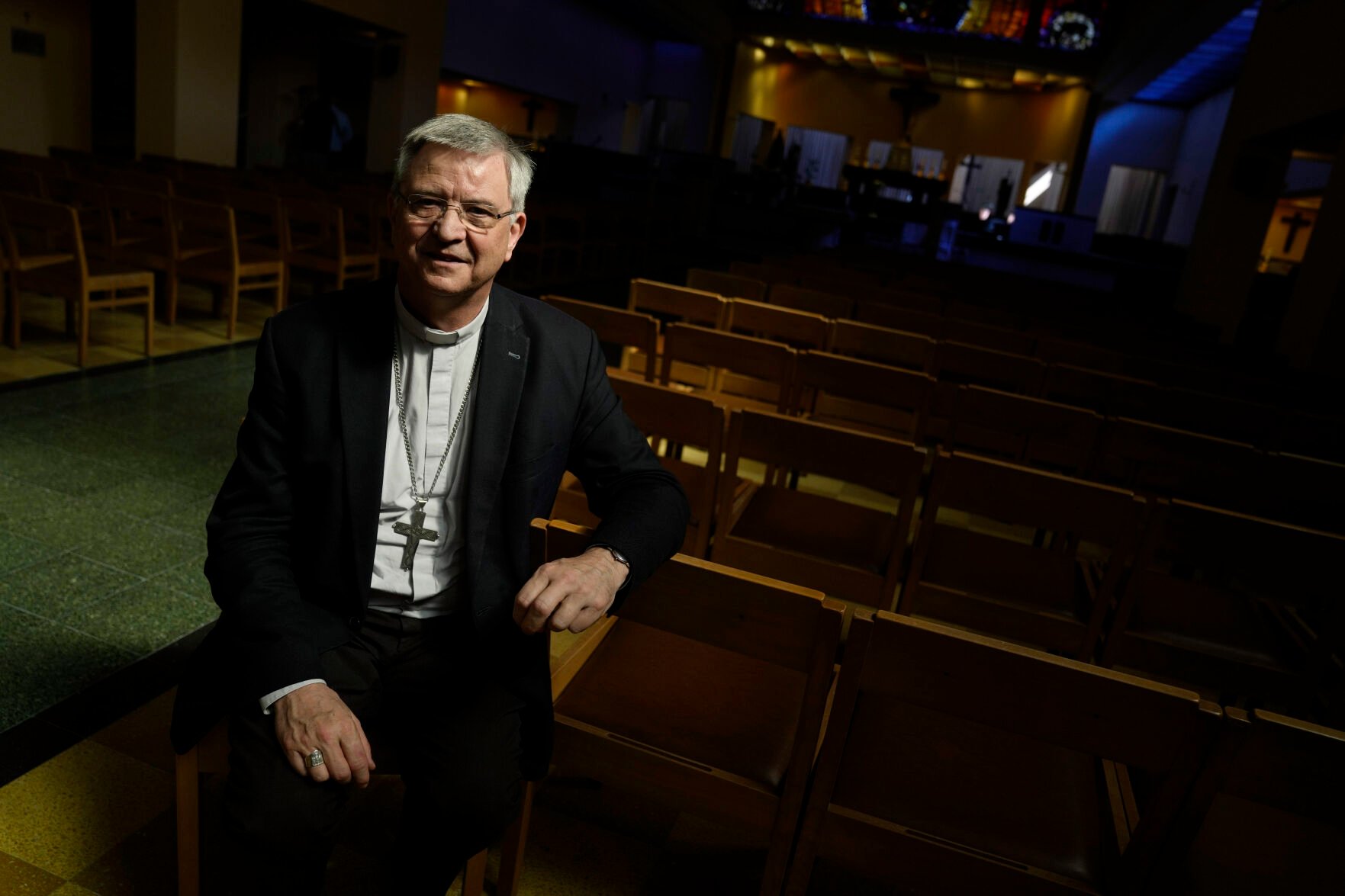
Virginia Mayo
Bishop of Antwerp, Johan Bonny, poses for a portrait at a church in Lier, Belgium, Wednesday, May 24, 2023. Across Europe, the continent that nurtured Christianity for most of two millennia, many churches, convents, beguinages and chapels stand empty and increasingly derelict as faith and church attendance have shriveled over the past half century. Many have now been repurposed for other activities to preserve their historical and architectural relevance. (AP Photo/Virginia Mayo)
Knowing the winding history of Christianity over centuries, Bonny takes the long view, since the near future does not look bright. “Every 300 years we nearly had to start again,” he said. “Something new, I’m sure, will happen. But it takes time.”
At the Martin’s Patershof, there is even is a condition that the church can reclaim the building if it is needed again, said De Preter. The hotel elements were built on steel beams and could be totally disassembled and taken out again. “If the church, at a certain point, wants the building back — which holds a very small chance, probably — it is possible.”
-
Europe’s many empty churches are being transformed into night clubs, breweries and more
Massimo Todaro // Shutterstock
On March 5, during Sunday Mass at St. Thomas Church in Thomaston, Connecticut, a parishioner noticed that the wafers, or hosts, given during Communion—also called the Eucharist—multiplied themselves inside the ciborium just as they were about to run out. With no explanation available other than alleged divine intervention, the Vatican is now investigating whether it was a true Eucharistic miracle. If confirmed, which is unlikely now due to a lack of physical evidence, it would be the first miracle of any kind declared by the Catholic Church in the United States.
Believing in miracles is a prerequisite of Roman Catholicism. Church doctrine teaches that Jesus, the son of God, enters the world by immaculate conception, or virgin birth. He rises from the dead. And in between the bookends of his life, he performed many alleged miracles, including walking on water, turning water into wine, and feeding a crowd of 5,000 people with only two fish and five loaves of bread.
In Catholicism, miracles are perceptible events with no natural or scientific explanation. But not just any random, inexplicable phenomenon gets the holy seal of approval. These events typically involve healing, curing, or strengthening faith and are most often discussed in the context of canonization, as performing a miracle is a required criterion of sainthood.
Over time, verifying these events has become more rigorous and scientific. Miracles evolved from being supernatural signs of God, according to the church, to proof of God. Where science finds future progress and discovery in inexplicable events—things yet to be solved—the Catholic Church finds God. They are two sides of the same coin; which side is up depends on who is holding it.
The church has a long history of preempting the skeptics in order to strengthen their arguments for proof. In 1587 Pope Sixtus V established the position of advocatus diaboli. The primary function of this role was to find any and every reason to question a person's candidacy for sainthood. This went beyond questioning the validity of miracles they performed to even include identifying selfish reasons for good deeds completed by the person in question. Today, we call people who present counterarguments like this a devil's advocate—or, in Latin, advocatus diaboli.
To better understand the history of Eucharistic miracles specifically, Stacker visualized every Eucharistic miracle the Vatican has declared, charting their prominence over regions and time with help from a list compiled by miracolieucaristici.org. The events only include those in which some action occurred and exclude relics or feasts often grouped in with Eucharistic miracles.

Massimo Todaro // Shutterstock
On March 5, during Sunday Mass at St. Thomas Church in Thomaston, Connecticut, a parishioner noticed that the wafers, or hosts, given during Communion—also called the Eucharist—multiplied themselves inside the ciborium just as they were about to run out. With no explanation available other than alleged divine intervention, the Vatican is now investigating whether it was a true Eucharistic miracle. If confirmed, which is unlikely now due to a lack of physical evidence, it would be the first miracle of any kind declared by the Catholic Church in the United States.
Believing in miracles is a prerequisite of Roman Catholicism. Church doctrine teaches that Jesus, the son of God, enters the world by immaculate conception, or virgin birth. He rises from the dead. And in between the bookends of his life, he performed many alleged miracles, including walking on water, turning water into wine, and feeding a crowd of 5,000 people with only two fish and five loaves of bread.
In Catholicism, miracles are perceptible events with no natural or scientific explanation. But not just any random, inexplicable phenomenon gets the holy seal of approval. These events typically involve healing, curing, or strengthening faith and are most often discussed in the context of canonization, as performing a miracle is a required criterion of sainthood.
Over time, verifying these events has become more rigorous and scientific. Miracles evolved from being supernatural signs of God, according to the church, to proof of God. Where science finds future progress and discovery in inexplicable events—things yet to be solved—the Catholic Church finds God. They are two sides of the same coin; which side is up depends on who is holding it.
The church has a long history of preempting the skeptics in order to strengthen their arguments for proof. In 1587 Pope Sixtus V established the position of advocatus diaboli. The primary function of this role was to find any and every reason to question a person's candidacy for sainthood. This went beyond questioning the validity of miracles they performed to even include identifying selfish reasons for good deeds completed by the person in question. Today, we call people who present counterarguments like this a devil's advocate—or, in Latin, advocatus diaboli.
To better understand the history of Eucharistic miracles specifically, Stacker visualized every Eucharistic miracle the Vatican has declared, charting their prominence over regions and time with help from a list compiled by miracolieucaristici.org. The events only include those in which some action occurred and exclude relics or feasts often grouped in with Eucharistic miracles.

-
Europe’s many empty churches are being transformed into night clubs, breweries and more
Emma Rubin // Stacker
The geographic distribution of miracles largely reflects regions with the largest number of Catholics at the time. During the Middle Ages—spanning roughly 1,000 years between A.D. 500 and 1400—Catholicism was the only recognized religion in Europe.
During the 20th century, however, the global distribution of Catholics changed dramatically. Latin America and the Caribbean overtook Europe as the region with the largest share of Catholics. The Middle East and North Africa, Sub-Saharan Africa, Asia-Pacific, and North America also saw growth in the percentage of Catholics living in those regions.
Emma Rubin // Stacker
The geographic distribution of miracles largely reflects regions with the largest number of Catholics at the time. During the Middle Ages—spanning roughly 1,000 years between A.D. 500 and 1400—Catholicism was the only recognized religion in Europe.
During the 20th century, however, the global distribution of Catholics changed dramatically. Latin America and the Caribbean overtook Europe as the region with the largest share of Catholics. The Middle East and North Africa, Sub-Saharan Africa, Asia-Pacific, and North America also saw growth in the percentage of Catholics living in those regions.
-
-
Europe’s many empty churches are being transformed into night clubs, breweries and more
Emma Rubin // Stacker
Medieval life—for peasants, nobles, and all classes in between—was heavily influenced by Christianity, perhaps more so than at any other point in history. Popes replaced kings as the ultimate authority with the power to raise armies and declare war. This led to a period of extreme religious persecution for non-Christians and resulted in horrific events such as the Crusades and the Inquisition. Even for Christians, the medieval period was a difficult time to be alive, as people faced war, famine, disease, and repressive social constructs.
While it is impossible to know for sure, reported miracles during this period could have been the result of two separate responses to the conditions of the time—the first being that the faithful were looking for miracles as a source of hope. Modern research shows that people—particularly those who already identify as religious—often turn to religious practices and services as a way to cope with times of trouble or sorrow. The second may be that miracles were used as a form of propaganda to justify this period of religious persecution. Academics have noted the church may have employed this strategy by communicating the lives of saints.
Reported miracles dropped as people alive during the Age of Reason espoused the concepts of empiricism, rationalism, and religious tolerance. As human understanding of the natural world evolved and science emerged to explain events that in the past would have been considered miracles, the number of declared miracles dropped sharply.
Emma Rubin // Stacker
Medieval life—for peasants, nobles, and all classes in between—was heavily influenced by Christianity, perhaps more so than at any other point in history. Popes replaced kings as the ultimate authority with the power to raise armies and declare war. This led to a period of extreme religious persecution for non-Christians and resulted in horrific events such as the Crusades and the Inquisition. Even for Christians, the medieval period was a difficult time to be alive, as people faced war, famine, disease, and repressive social constructs.
While it is impossible to know for sure, reported miracles during this period could have been the result of two separate responses to the conditions of the time—the first being that the faithful were looking for miracles as a source of hope. Modern research shows that people—particularly those who already identify as religious—often turn to religious practices and services as a way to cope with times of trouble or sorrow. The second may be that miracles were used as a form of propaganda to justify this period of religious persecution. Academics have noted the church may have employed this strategy by communicating the lives of saints.
Reported miracles dropped as people alive during the Age of Reason espoused the concepts of empiricism, rationalism, and religious tolerance. As human understanding of the natural world evolved and science emerged to explain events that in the past would have been considered miracles, the number of declared miracles dropped sharply.
-
Europe’s many empty churches are being transformed into night clubs, breweries and more
Emma Rubin // Stacker
Every Catholic Mass includes the sacrament of Holy Communion—when the hosts and wine are consecrated through prayer and, according to the church, turned into the actual body and blood of Christ through a process called transubstantiation, which allows them to retain their physical appearance.
But in almost half of all Eucharistic miracles throughout history, the hosts, and occasionally the wine, took on the traits of real flesh and blood. The wafers have been said to drip blood or left blood stains on surfaces they came into contact with.
In the 2008 miracle of Sokolka, Poland, a bloody host taken for scientific testing by two histopathologists revealed its makeup was identical to the myocardial, or heart, tissue of a living person who was on the verge of death. The heart muscle fibers were intertwined with the bread in a way that no human could have achieved through their own intervention, according to the church's citation of the study. There have been at least two other similar miracles where studies have allegedly revealed the presence of heart muscle fibers in the bleeding hosts. None of the research has been made publicly available.
In nearly two dozen Eucharistic miracles, hosts that should have been destroyed by floods, fire, or thieves allegedly survived unharmed. In other events, images of God appeared on the hosts.
Emma Rubin // Stacker
Every Catholic Mass includes the sacrament of Holy Communion—when the hosts and wine are consecrated through prayer and, according to the church, turned into the actual body and blood of Christ through a process called transubstantiation, which allows them to retain their physical appearance.
But in almost half of all Eucharistic miracles throughout history, the hosts, and occasionally the wine, took on the traits of real flesh and blood. The wafers have been said to drip blood or left blood stains on surfaces they came into contact with.
In the 2008 miracle of Sokolka, Poland, a bloody host taken for scientific testing by two histopathologists revealed its makeup was identical to the myocardial, or heart, tissue of a living person who was on the verge of death. The heart muscle fibers were intertwined with the bread in a way that no human could have achieved through their own intervention, according to the church's citation of the study. There have been at least two other similar miracles where studies have allegedly revealed the presence of heart muscle fibers in the bleeding hosts. None of the research has been made publicly available.
In nearly two dozen Eucharistic miracles, hosts that should have been destroyed by floods, fire, or thieves allegedly survived unharmed. In other events, images of God appeared on the hosts.
-
-
Europe’s many empty churches are being transformed into night clubs, breweries and more
Canva
In 2016, Pope Francis changed how the church assesses miracles, making the process more rigorous and transparent, particularly with regard to funding and scientific evaluation. An investigation three years earlier, led by a commission appointed by Pope Francis, revealed widespread failures and vulnerabilities that were being exploited. His commission found that the verification system approved by Pope St. John Paul II in 1983 led to the beatification of 1,138 persons and canonization of 482 saints—more than all his predecessors combined since 1588. It was also revealed that money played an important factor in advancing some of these individuals.
Pope Francis also declared that two-thirds of the medical board assessing miraculous events must affirm that natural causes were not at play. Previously, the confirmation process only required a majority. This medical perspective is recent in the long history of Catholicism but has been around for centuries. Pope Benedict XIV, former advocatus diaboli, served during the Age of Enlightenment and, in 1743, instituted the first order of medical experts to verify miracles in order to approve sainthood.
Data reporting by Emma Rubin. Story editing by Brian Budzynski. Copy editing by Tim Bruns.
Canva
In 2016, Pope Francis changed how the church assesses miracles, making the process more rigorous and transparent, particularly with regard to funding and scientific evaluation. An investigation three years earlier, led by a commission appointed by Pope Francis, revealed widespread failures and vulnerabilities that were being exploited. His commission found that the verification system approved by Pope St. John Paul II in 1983 led to the beatification of 1,138 persons and canonization of 482 saints—more than all his predecessors combined since 1588. It was also revealed that money played an important factor in advancing some of these individuals.
Pope Francis also declared that two-thirds of the medical board assessing miraculous events must affirm that natural causes were not at play. Previously, the confirmation process only required a majority. This medical perspective is recent in the long history of Catholicism but has been around for centuries. Pope Benedict XIV, former advocatus diaboli, served during the Age of Enlightenment and, in 1743, instituted the first order of medical experts to verify miracles in order to approve sainthood.
Data reporting by Emma Rubin. Story editing by Brian Budzynski. Copy editing by Tim Bruns.





